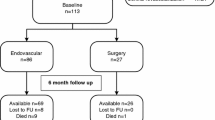Abstract
Background
An increased operative time (OT) has been associated with a higher rate of adverse outcomes after several surgical procedures although scarce evidence exists for infrainguinal bypass surgery (IBS) and its impact beyond the postoperative period. The aim of this study was to define surgical characteristics related to a prolonged OT in IBS for chronic limb threatening ischemia and its influence on postoperative and 1-year outcomes.
Materials and methods
Retrospective study of 249 consecutive patients (mean age 72.4 years, 73.1% male) undergoing IBS for CLI between 2008 and 2018. The characteristics related to the duration of surgery and its impact on outcome were assessed with a multiple linear regression and a multivariate logistic regression, respectively.
Results
Interventions associated with a prolonged OT included the bypass to a below-the-knee artery (additional 36 min, p = 0.002), the need for an alternative vein or a hybrid PTFE-vein graft (additional 37 min, p = 0.02) and inflow associated procedures (additional 47 min, p < 0.001). OT was associated with a higher rate of postoperative complications (OR for each additional 30 min 1.123, 95% CI 1.021–1.234) and need for a sociosanitary facility at discharge (OR 1.143, 95% CI 1.033–1.265). At 1-year of follow-up, OT was related to a higher major amputation rate (OR 1.201, 95% CI 1.036–1.393) and non-significantly to mortality (OR 1.125, 95% CI 0.999–1.268).
Conclusions
A prolonged OT is a risk factor for adverse outcomes after IBS that extends beyond the immediate postoperative period. Further research is needed to evaluate how an expected high OT might influence decision-making.
Similar content being viewed by others
References
Cheng H, Clymer JW, Po-Han Chen B et al (2018) Prolonged operative duration is associated with complications: a systematic review and meta-analysis. J Surg Res 229:134–144
Wills B, Sheppard E, Smith W et al (2018) Impact of operative time on early joint infection and deep vein thrombosis in primary total hip arthroplasty. Orthop Traumatol Surg Res 104:445–448
Maggino L, Liu J, Ecker B et al (2018) Impact of operative time on outcomes after pancreatic resection: a risk-adjusted analysis using the American College of Surgeons NSQIP database. J Am Coll Surg 226:844–857
Ondeck N, Bohl D, McLynn R et al (2018) Longer operative time is associated with increased adverse events after anterior cervical diskectomy and fusion: 15-minute intervals matter. Orthopedics 41:483–488
Bohl D, Ondeck N, Darrith B et al (2018) Impact of operative time on adverse events following primary total joint arthroplasty. J Arthroplast 33:2256–2262
Jeon B, Kim H, Jung K et al (2016) Prolonged operative time in laparoscopic appendectomy: predictive factors and outcomes. Int J Surg 36:225–232
Cornellà N, Sancho J, Sitges-Serra A (2017) Short and long-term outcomes after surgical procedures lasting for more than six hours. Sci Rep 7:1–8
Aziz F, Lehman E, Reed A (2016) Increased duration of operating time for carotid endarterectomy is associated with increased mortality. Ann Vasc Surg 36:166–174
Valsangkar N, Salfity H, Timsina L et al (2018) Operative time in esophagectomy: does it affect outcomes? Surgery 164:866–871
Shah N, Hamilton M (2013) Clinical review: can we predict which patients are at risk of complications following surgery? Crit Care 17:226
Perri J, Nolan B, Goodney P et al (2017) Factors affecting operative time and outcome of carotid endarterectomy in the vascular quality initiative. J Vasc Surg 66:1100–1108
Landry G, Liem T, Abraham C et al (2019) Predictors of perioperative morbidity and mortality in open abdominal aortic aneurysm repair. Am J Surg 217:943–947
Boitano L, Iannuzzi J, Tanious A et al (2019) Predicting postoperative destination through preoperative evaluation in elective open aortic aneurysm repair. J Surg Res 235:543–550
Duan C, Jia S, Liu J et al (2015) Abdominal aortic aneurysm treated by endovascular stent graft and conventional surgical repair for overweight and obesity patients: a comparison early result. Zhonghua Wai Ke Za Zhi 53:415–418
Shu J, Santulli G (2018) Update on peripheral artery disease: epidemiology and evidence-based facts. Atherosclerosis 275:379–381
Komshian Sevan R, Kimberly Lu, Pike Steven L, Siracuse Jeffrey J (2017) Infrainguinal open reconstruction: a review of surgical considerations and expected outcomes. Vasc Health Risk Manag 13:161–168
Chang J, Calligaro K, Ryan S et al (2003) Risk factors associated with infection of lower extremity revascularization: analysis of 365 procedures performed at a teaching hospital. Ann Vasc Surg 17:91–96
Tan T, Kalish J, Hamburg N et al (2012) Shorter duration of femoral-popliteal bypass is associated with decreased surgical site infection and shorter hospital length of stay. J Am Coll Surg 215:512–518
Lee D, Li J, Wang G et al (2017) Looking inward: the impact of operative time on graft survival after liver transplantation. Surgery 162:937–949
Inaba CS, Koh CY, Sujatha-Bhaskar S et al (2019) Operative time as a marker of quality in bariatric surgery. Surg Obes Relat Dis 15:1113–1120
Khuri S, Henderson W, DePalma R et al (2005) Determinants of long-term survival after major surgery and the adverse effect of postoperative complications. Ann Surg 123:32–48
Author information
Authors and Affiliations
Corresponding author
Ethics declarations
Conflict of interest
The authors declare that they have no conflict of interest.
Additional information
Publisher's Note
Springer Nature remains neutral with regard to jurisdictional claims in published maps and institutional affiliations.
Rights and permissions
About this article
Cite this article
Almorza, C., Marcos, L., Diaz, C. et al. Influence of Operative Time in the Results of Infrainguinal Bypass for Chronic Limb Threatening Ischemia. World J Surg 44, 4261–4266 (2020). https://doi.org/10.1007/s00268-020-05726-5
Accepted:
Published:
Issue Date:
DOI: https://doi.org/10.1007/s00268-020-05726-5




